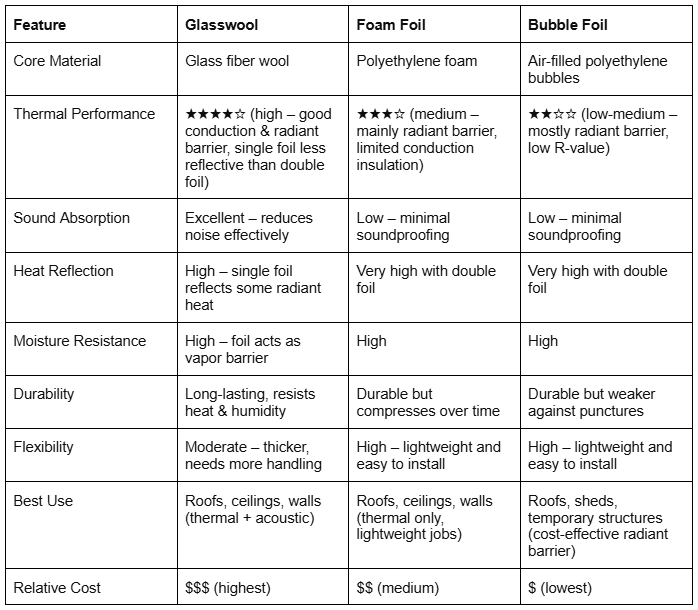When it comes to keeping your home or building comfortable and energy-efficient, insulation plays a critical role. Among the many insulation options available, foil-based insulations have gained popularity due to their versatility, thermal performance, and ease of installation. But not all foil insulations are the same. Let’s explore the most common types and how to choose the right one for your needs.
1. Glasswool Foil Glasswool Insulation
Glasswool insulation consists of fine glass fibers compressed into mats or rolls. When combined with a single-sided aluminium foil, it provides effective thermal insulation while keeping installation simple.
Benefits:
- High thermal resistance (R-value) for both hot and cold climates.
- Fire-resistant and non-combustible.
- Reduces noise and vibration.
- Durable and long-lasting.
Typical Applications:
- Roofs and ceilings in tropical climates.
- Walls where thermal insulation is required with minimal foil coverage.
2. Foam Foil Insulation
Foam insulation, such as polyurethane or polystyrene boards, can be laminated with aluminium foil on both sides, enhancing thermal resistance and providing an additional barrier to heat and moisture.
Benefits:
- Lightweight and easy to handle.
- Excellent thermal insulation due to closed-cell structure.
- Acts as a moisture barrier on both sides.
- Ideal for spaces with limited thickness options.
Typical Applications:
- Walls, floors, and ceilings in residential and commercial buildings.
- Areas where moisture control is crucial, such as bathrooms or kitchens.
3. Bubble Foil Insulation
Foil bubble insulation is made from layers of polyethylene bubbles sandwiched between reflective foil on both sides, making it an excellent radiant heat barrier.
Benefits:
- Extremely lightweight and flexible.
- Reflects radiant heat efficiently from both sides.
- Easy to install and cut to size.
- Works well as a secondary insulation layer.
Typical Applications:
- Attics and roofs where radiant heat is significant.
- Temporary or portable structures, such as sheds or greenhouses.
- Retrofits in existing buildings to improve thermal performance.
Choosing the Right Foil Insulation
When selecting foil insulation, consider:
- Thermal performance: Check the R-value or reflective efficiency.
- Space constraints: Foam boards are great where thickness is limited.
- Moisture resistance: Double-sided foil materials provide enhanced vapor barriers.
- Noise reduction needs: Glasswool is ideal for acoustic insulation.
- Ease of installation: Bubble foil insulation is lightweight and easy to handle.

Foil insulation offers a versatile solution for managing heat, saving energy, and improving comfort. Whether you choose single-sided glasswool, double-sided foam, or double-sided bubble foil, each type has unique strengths suited to different applications. Properly selected and installed, foil insulation can make a noticeable difference in indoor comfort and energy costs.